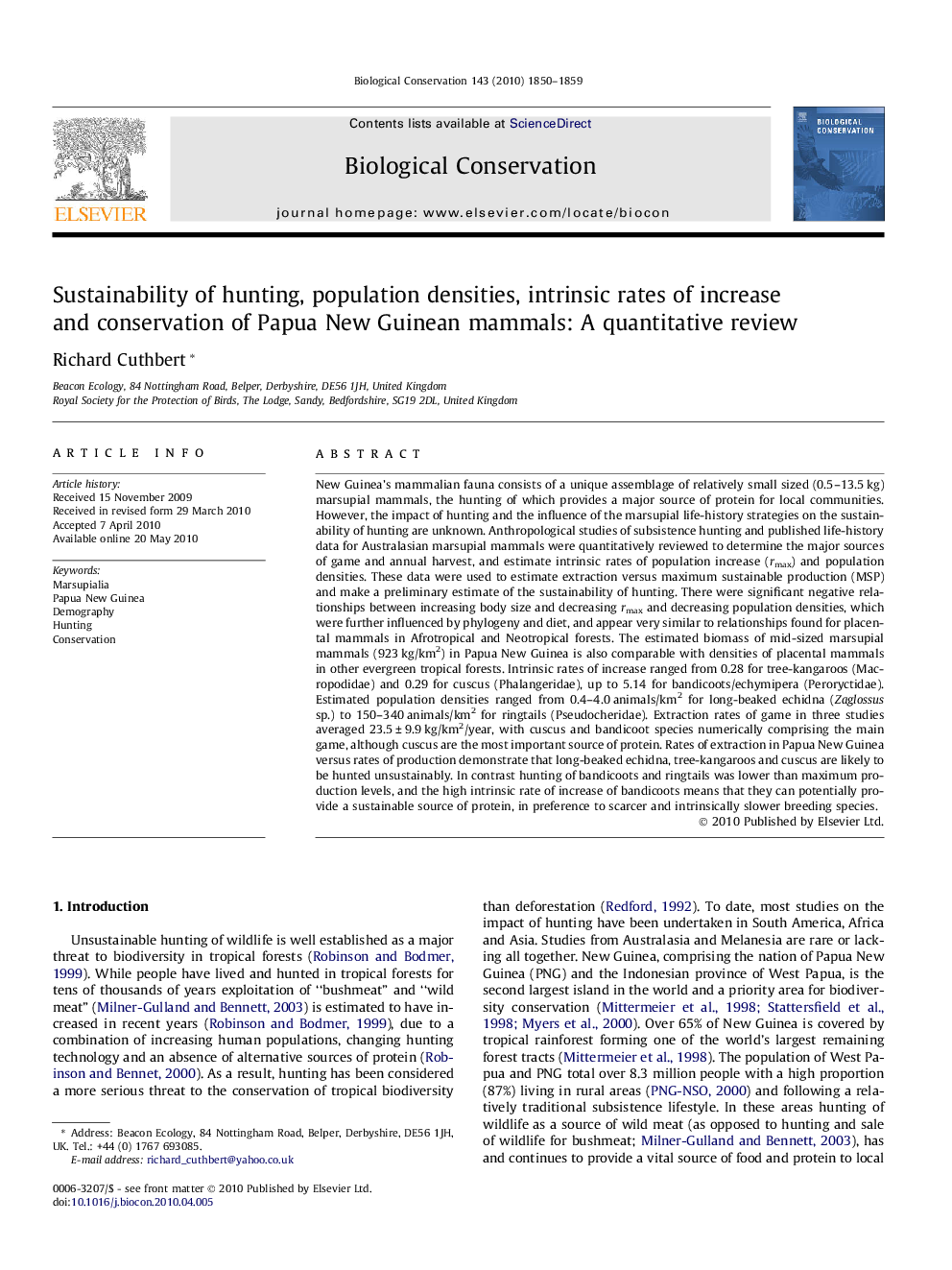| کد مقاله | کد نشریه | سال انتشار | مقاله انگلیسی | نسخه تمام متن |
|---|---|---|---|---|
| 4386179 | 1304559 | 2010 | 10 صفحه PDF | دانلود رایگان |
عنوان انگلیسی مقاله ISI
Sustainability of hunting, population densities, intrinsic rates of increase and conservation of Papua New Guinean mammals: A quantitative review
دانلود مقاله + سفارش ترجمه
دانلود مقاله ISI انگلیسی
رایگان برای ایرانیان
کلمات کلیدی
موضوعات مرتبط
علوم زیستی و بیوفناوری
علوم کشاورزی و بیولوژیک
بوم شناسی، تکامل، رفتار و سامانه شناسی
پیش نمایش صفحه اول مقاله

چکیده انگلیسی
New Guinea's mammalian fauna consists of a unique assemblage of relatively small sized (0.5-13.5 kg) marsupial mammals, the hunting of which provides a major source of protein for local communities. However, the impact of hunting and the influence of the marsupial life-history strategies on the sustainability of hunting are unknown. Anthropological studies of subsistence hunting and published life-history data for Australasian marsupial mammals were quantitatively reviewed to determine the major sources of game and annual harvest, and estimate intrinsic rates of population increase (rmax) and population densities. These data were used to estimate extraction versus maximum sustainable production (MSP) and make a preliminary estimate of the sustainability of hunting. There were significant negative relationships between increasing body size and decreasing rmax and decreasing population densities, which were further influenced by phylogeny and diet, and appear very similar to relationships found for placental mammals in Afrotropical and Neotropical forests. The estimated biomass of mid-sized marsupial mammals (923 kg/km2) in Papua New Guinea is also comparable with densities of placental mammals in other evergreen tropical forests. Intrinsic rates of increase ranged from 0.28 for tree-kangaroos (Macropodidae) and 0.29 for cuscus (Phalangeridae), up to 5.14 for bandicoots/echymipera (Peroryctidae). Estimated population densities ranged from 0.4-4.0 animals/km2 for long-beaked echidna (Zaglossus sp.) to 150-340 animals/km2 for ringtails (Pseudocheridae). Extraction rates of game in three studies averaged 23.5 ± 9.9 kg/km2/year, with cuscus and bandicoot species numerically comprising the main game, although cuscus are the most important source of protein. Rates of extraction in Papua New Guinea versus rates of production demonstrate that long-beaked echidna, tree-kangaroos and cuscus are likely to be hunted unsustainably. In contrast hunting of bandicoots and ringtails was lower than maximum production levels, and the high intrinsic rate of increase of bandicoots means that they can potentially provide a sustainable source of protein, in preference to scarcer and intrinsically slower breeding species.
ناشر
Database: Elsevier - ScienceDirect (ساینس دایرکت)
Journal: Biological Conservation - Volume 143, Issue 8, August 2010, Pages 1850-1859
Journal: Biological Conservation - Volume 143, Issue 8, August 2010, Pages 1850-1859
نویسندگان
Richard Cuthbert,